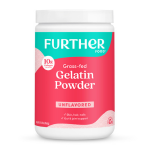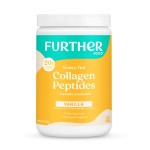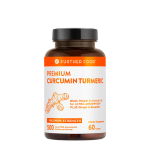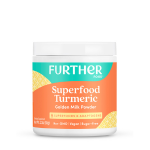I Said No to a Lifetime of Meds…How Going Grain Free Calmed My Colitis and Let Me Live Again

I can trace my passion for cooking back to a failure in the kitchen when I was in college. It was my first time attempting a meal totally on my own, and I vividly remember proudly serving a platter of Chicken Parmigiana to a houseful of college boys. After anticipating a delicious, home-cooked meal, they cut into their chicken only to find that it was grossly undercooked. I later learned that the chicken breasts needed to be pounded into cutlets to ensure even and quick cooking.
That was the first of many culinary failures, but it sparked a hunger in me. The Food Network became the background to my studies, and cooking magazines smothered my textbooks. I had a newfound interest in how and why dishes worked or didn’t, but out of fear of poisoning everyone around me, I spent the remainder of my college years cooking what was familiar and comfortable.
It wasn’t until I graduated that I started to actually experiment with new foods. But not by choice. After a few months of experiencing gastrointestinal upset, fatigue, and unexplainable anemia, I received a diagnosis of ulcerative colitis — an autoimmune disease that attacks the intestines. I was prescribed a myriad of harsh medications to be taken multiple times a day but still experienced terrible symptoms. My various doctors refused to speak to me about dietary changes and assured me that food could not cure the disease. Through my own research and reaching out to others in online communities, I discovered that I could, in fact, drastically change my approach to eating to alleviate my symptoms.
To my dismay, I learned that I needed to remove grains, lactose, and refined sugars. Gone were the days of convenience when a meal could come from a jar of spaghetti sauce, a package of pasta, and frozen hamburger meat. All-purpose flour and white sugar, which had been staples for me, were no longer options. Whatever I knew about cooking would no longer serve me. It was back to square one.
After trying a few recipes I found on the Internet and tossing them in the trash because they were inedible, I came up with a mission: to never again miss the food I once loved. I set forth to create grain-free, dairy-free dishes that were reminiscent of the standard American diet, but were wholesome and made from fresh ingredients — things that would leave a person feeling satisfied rather than deprived.
But let me backtrack a bit, because it is important to comprehend the gravity of my pain and suffering to understand why this mission became my passion.
In 2007, a mere two months after graduation from college and marrying my high-school sweetheart, I found myself in the emergency room suffering from unbearable pain in my abdomen and a slew of digestive complications. Until then, I had been a perfectly healthy young woman, with no family history of digestive disorders and only the occasional stomach upset as a child. The hospital discharged me without a diagnosis and gave me a prescription for medication that ultimately intensified my symptoms.
A few agonizing weeks, three specialists, and one lengthy hospital admittance later, I was finally given a diagnosis of ulcerative colitis — a disease similar to Crohn’s disease. I was again discharged with a handful of prescriptions and a promise that, while there was no cure for the disease, I could ultimately live a very “normal” life. The doctors didn’t discuss the symptoms I might experience or even the side effects the drugs might cause.
About six months later, I found myself in a hospital room in Kampala, Uganda, pleading for my life as I lay precariously near death. My husband and I had been planning for a year to partake in a humanitarian trip to work in the refugee camps in northern Uganda. While I had experienced minor discomfort and symptoms before we left the States, I was in no way aware of the severity of this disease, and so we had decided to follow through with our plans.
In Uganda, I was racked with debilitating pain that forced me into a wheelchair, became severely anemic, and dropped twenty pounds in ten days. I was administered a vast dose of 100mg of intravenous steroids daily, which provoked more side effects than the initial symptoms they were intended to mitigate. After a weeklong stay in the two-room hospital in Kampala, the doctors concluded that the thirty-six-hour journey back to the US for a blood transfusion was imperative: doing so in a country rampant with disease was simply too risky.
That episode was the first of many that landed me in hospitals over and over again and launched me into a world of harsh drug therapies that only exacerbated my condition. It also led to a grave frustration with the lack of awareness the traditional medical establishment had regarding diet and alternative therapies. A mere twenty-five years old, I couldn’t fathom the thought of taking immunosuppressant medications and being subjected to frequent flare-ups for the rest of my life. It was at that point that I realized I would need to resort to my own research and acquired the tenacity to heal myself through food.
Two years after my initial diagnosis, I was introduced to the Specific Carbohydrate Diet (SCD), which has been used for decades to manage the symptoms of Crohn’s disease, ulcerative colitis, celiac disease, and autism. Rather than resigning myself to a life sentence of pain and suffering, I went on the offensive. I implemented the SCD and began to feel minor relief almost immediately. It took a lot of time, and even more discipline, to see drastic changes, but the first inklings of improvement gave me hope. I knew I would have to start over entirely in the kitchen, but it was a small price to pay for my health.
After a few months of eating grain-free and witnessing an upswing in my health, I became pregnant and gave birth to my son, Asher, in the summer of 2010. As is often the case with autoimmune diseases, my symptoms disappeared while I was pregnant. When a woman is pregnant, her immune system essentially shuts down so as not to fight off the new “foreign object” in her body. This is beneficial for someone whose immune system is normally working overtime, falsely attacking otherwise healthy organs. The only problem was that because I felt well, I reverted to eating what had historically been comfort food for me — mainly pizza, ice cream, and French fries!
About nine months after Asher’s birth, the hormonal shifts and my food indulgences caught up with me, and I experienced another major flare-up. I was hospitalized yet again, unable to take care of my baby and regretting the bad decisions I’d made while I was pregnant. In order to take care of my family, I had to take care of myself, meaning a strict return to a grain-free diet. With the tastes and textures of those “comfort” foods still fresh on my palate, I embarked on my quest to create versions of the dishes that I could actually enjoy and that my body could tolerate.
As I began my culinary experimentations, I noticed a lack of innovative recipes as well as personal accounts of setbacks and progress, and wanted to document my journey to help others. I decided to combine the power of my acquired culinary skills, my love for food, and my equal love for journalism, and started my blog, Against All Grain.
I transformed my small home kitchen into a formidable command center for culinary operations. I spent, and still spend, countless hours reinventing recipes, converting the taboo and decadent into dishes that those who suffer from digestive disorders or autoimmune diseases can eat and enjoy. My goal was to banish the feeling of deprivation, to feel not just satisfied but exhilarated with each and every bite.
Because my disease was never fully in remission while on the SCD, I realized that I might still be consuming foods that were in fact hurting me. Over time, and with the help of a naturopath, I began to modify the SCD to fit my particular food sensitivities and started a supplement regimen to aid in healing my gut. Through trial and error, and health advances and setbacks, I discovered what my body could process and what it couldn’t. I learned that each body may have different nuances and that there is not one diet that necessarily solves everyone’s problems.
I also came to the realization that the way food is grown or raised (grass-fed versus grain-fed meat, for instance) was affecting my health. With these findings, I continued my research and discovered the Paleo diet, which excludes grains, legumes, refined sugars, and most dairy. This way of eating mimicked the direction I was already heading and I embraced it wholeheartedly. Almost immediately, the remaining health issues I continued to experience began to dissipate.
My symptoms have continued to abate since making the transition to Paleo, and I have not been hospitalized since the summer of 2011. Like any human, though, I still struggle daily with making the right choices and my yearning to eat what everyone else does. If I’m not careful and don’t adhere closely to a Paleo diet or if I don’t take care of myself and my stress well, I will see symptoms return. What keeps me pressing onward is the knowledge that the Paleo diet allowed for such a drastic personal health transformation and how much it can benefit those with digestive and autoimmune disorders. I initially perceived this way of eating as a solution for my particular disease, but now continue to learn from my readers who are using it to reduce or eliminate a the plethora of ailments like diabetes, multiple sclerosis, and chronic fatigue syndrome, to name a few.
I’m honored daily to hear new stories about my readers finding healing and a new level of enjoying a life of vitality. Never in my wildest dreams could I have imagined that my suffering could lead to a career in helping other people change their lives. I never even dreamed that my little blog would grow so rapidly in dedicated readership and have the ability to help so many people enjoy eating again, or that I would generate the opportunity to write cookbooks. The saying goes to make lemonade out of lemons, and I’m so grateful that my adversity could be transformed into something so positive.
Excerpted with permission from Against All Grain: Delectable Paleo Recipes to Eat Well & Feel Great.
Want more? You might also like:
6 Rules For Navigating Parties with Crohn’s or Colitis
My Story: Healing Ulcerative Colitis by Going Green
I Took Control of Crohn’s & Got Off My Meds by Changing My Diet
From 20 Pills a Day to Remission: How I Beat Crohn’s Using Food!
Note: PLEASE consult with your doctor before making any changes to your diet or medications. The material on this site is provided for educational purposes only, and is not to be used for medical advice, diagnosis or treatment.
























